Discovering Home
Introduction
Text-to-speech Audio
Images
Come inside our replica of a wigwam! The covering is off to make it easier to see how it was built.When the Inoca people moved into their winter villages, they lived in structures called wigwams. A wigwam has a rounded framework of wooden poles tied together. Two layers of mats woven from reeds or rushes covered the outside of the framework making the structure warm and dry. These mats might be 6 feet wide and 60 feet long. The wigwams of the Inoca could be 15 feet wide and 25 feet long. With a hearth in the center, a door at one end, and sleeping and living areas around the outside, one or two families called a wigwam home.
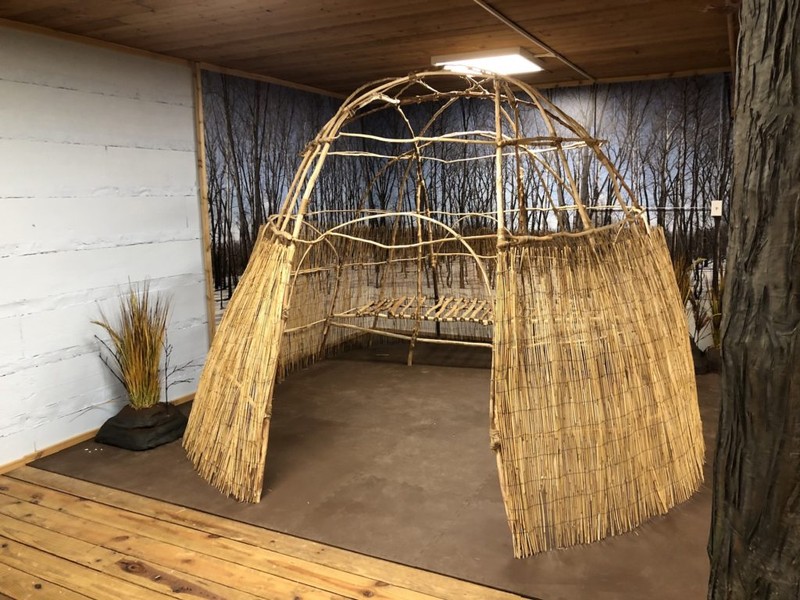
Early settlers to Illinois could not bring many animals with them as they travelled west, but they did bring pigs. Pigs were tough. They grew quickly, and didn’t need to be fenced. They could find their own food, and did not require a lot of care. Plus, pigs provided a lot of things that settlers needed.
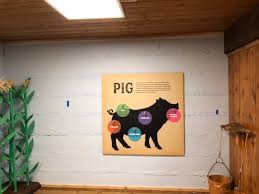
This 18th century painting depicts the Inoca natives. Early French explorers described the Inoca as fine and grace people who were full of life. The men were heavily tattooed and often acted as war chiefs and peace chiefs. Influential women served as peace chiefs, too.
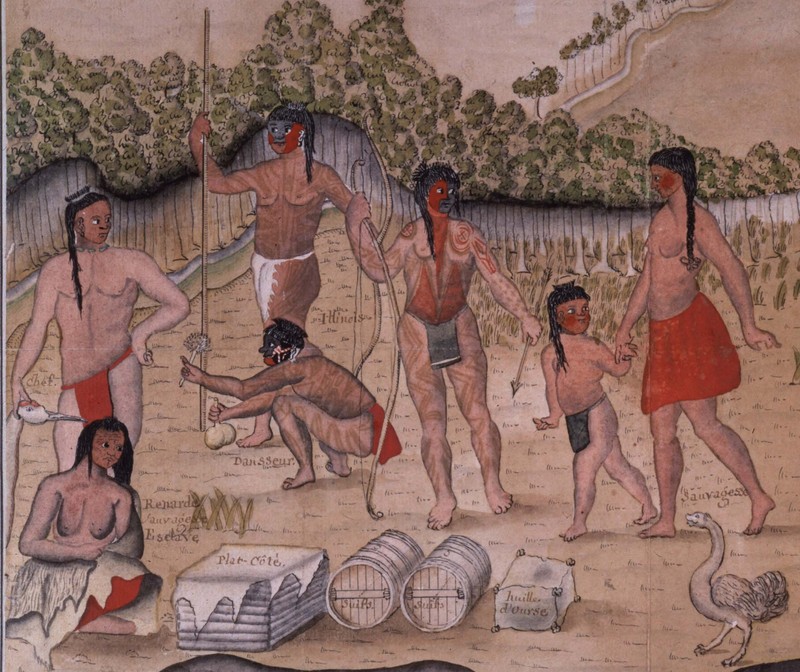
For over 10 years, Frieda Anderson Mumm was dedicated to her volunteer work at the Museum of the Grand Prairie. She was a founding member of the Harvesters, the program which ran the museum’s first education programs. Frieda churned butter, rendered fat and created lye soap, and was one of the first school marms in our one-room schoolhouse. Growing up on a farm herself, she eagerly shared her own experiences with schoolchildren and the public. But she also volunteered tirelessly behind the scenes, almost full-time, organizing files and doing research during the 1980s and 1990s. Frieda died in 2014, leaving a bequest to the museum to be used in support of education. A portion of those funds were used to create this exhibit. Her dedication and generosity will live on in the enjoyment you, and others like you, have Discovering Home.
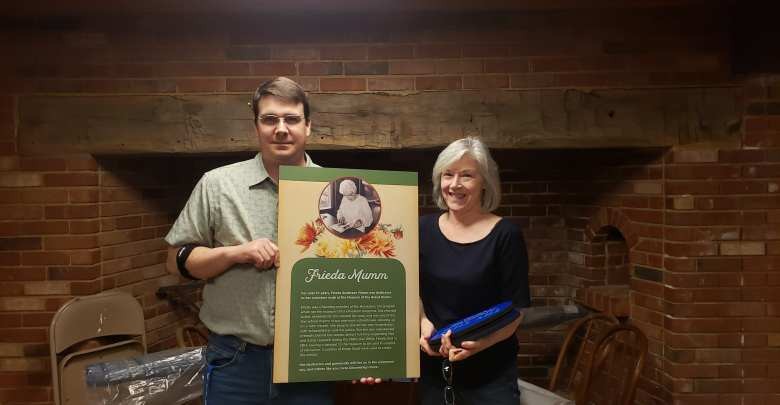
Early European Settler Log Cabin in Exhibit
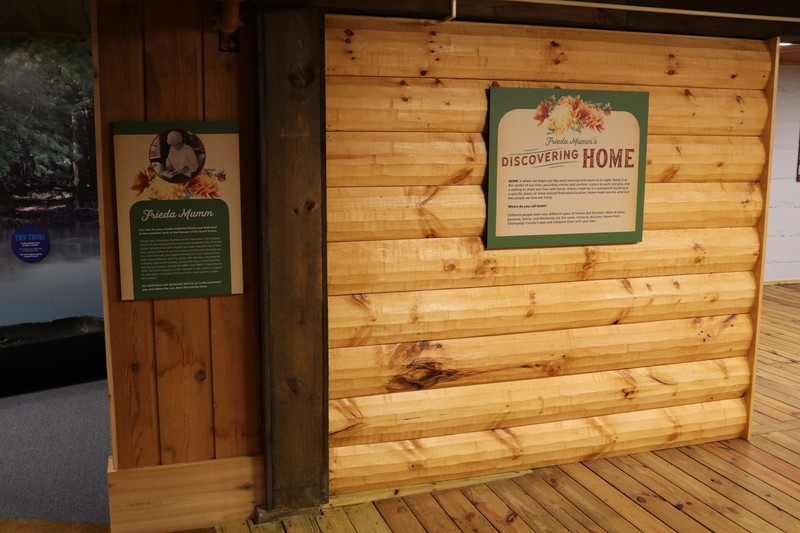
Backstory and Context
Text-to-speech Audio
Home is where we begin our day each morning and return to at night. Home is at the center of our lives, providing shelter and comfort, a place to work and play, and a setting to share our lives with family. Homes might be in a permanent building at a specific place, or move around from place to place. Home might also be wherever the people we love are living.
Different people have very different types of homes, but the basic ideas of place, purpose, family, and familiarity are the same. Come discover homes from Champaign County’s past, and compare them with your own.
Long before European explorers and settlers came, the Inoca people lived in the area that is now east central Illinois and Champaign County. You might know these people by their French name, Illini. Many different tribes that shared a common way of life made up the Inoca Nation. They included the Cahokia, Kaskaskia, Michegamea, Peoria, and Tamaroa people. Their homes were not in one place, but in multiple places throughout the region. They moved three times a year. During the spring and late summer, they lived in larger villages near fields and water where they grew and harvested maize, squash, and beans. They moved into temporary camps during the summer to hunt on the prairies, and when winter came, the people lived small villages near rivers. The word that means moving between homes in permanent villages and temporary camps is semi-sedentary.
When settlers came to east central Illinois and Champaign County beginning in the 1830s and 1840s, they were looking for places to stop and stay. Families settled on specific pieces of land near woods and water, sometimes called homesteads. They farmed small parcels of land. They built permanent structures, like cabins and barns, and lived and worked in them all year long. The word that means living in a single home in the same place all year is sedentary.
The first structure a settler built was often a log cabin. They were quick to build and required very few tools. In the river timbers and groves, wood was plentiful. A log cabin is a simple box-shaped building made from stacked logs. A mixture mud or clay and plant material, called daub, filled the spaces between the logs. Eventually, settlers would build larger, wooden frame or brick houses; more like houses people live in today.
Before electric washing machines and dryers, clothes had to be washed by hand. Clothes would be scrubbed and rubbed with soap along a washboard, a bumpy metal surface inside a wooden frame that helped wash out dirty shirts, pants, and other clothing. Many early forms of laundry soap were made out of lye (treated wood ash) and various animal fats. A variety of household substances might have been used on tough stains. Clay, chalk, and brick dust were used on greasy stains. Alcohol treated grass stains. Kerosene was used to get out bloodstains. Milk was thought to remove urine stains. Ironically, urine, due to the high ammonia amount of ammonia was used often for bleaching as were lemon and onion juice.
Today if we want water, we can just turn on a faucet, but early settlers did not have indoor plumbing. They had to carry their water from the nearest stream or river. Water is heavy! Buckets were attached to the ends of a wooden yoke. The yoke rested on a person’s shoulders to make carrying the heavy buckets easier.
When European settlers first arrived to North America, they brought apples and apple seeds along with them. Apples were easy to grow and were often the first thing a farmer planted. Apples could be kept for a long time in fruit cellars, a type of cold storage. Aside from picking apples and eating them fresh, early settlers preserved apples in many other ways, such as making apple jams and jellies and even apple cider. Most early ciders were alcoholic beverages because without refrigeration, it would ferment. At one point in American history, cider was the most popular available beverage, more so than fresh water!
Corn was originally a Native American crop, but European settlers quickly adopted it. Corn was relatively easy to grow and harvest and had many uses. The ears of corn were eaten or ground into the corn meal. The ears and leaves were fed to pigs and other livestock, corncobs were burned for fuel, and dried leaves made into dolls. Corn was an important crop in east central Illinois, like it still is today.
Early settlers wore simple clothes that they often made themselves. They did not have closets full of clothes though, so they tried to take good care of the clothes they had. Can you imagine wearing the same clothes day after day?
The fireplace was the only source of heat in small log cabin and it was also the kitchen. Food would be prepared on the fire, and usually served on a nearby table. Sometimes there might be chairs, but simple benches were also common. Hearths like this were often built to be easily pulled away from the house in the case of a fire.
A hearth is the area around a fireplace. For many settlers, the hearth was the center of home. The hearth provided, heat light, and a place to cook. It also provided a place for people to talk and tell stories. The fire ring in wigwams did these same things, too.
Today, most people do not think of hearths and fire rings as the center of their home. Many homes do not even have them. Instead, people today might use the kitchen or family room as the center of their homes. They might gather around the kitchen table or a television.
This hearth is an original part of the museum building, and was never in a home. It is modeled on fireplaces from colonial times. It is much bigger than a hearth for a log cabin, but a large house might need many pots boiling at once. They would fit here. It is a good example to explore!
As we live our lives, we often leave home. Sometimes we are only gone for a little while, like when we are at school or shopping. Sometimes we are gone much longer, like when we are on vacation, away at college, or serving in the military. Sometimes people even leave one home to move to a new home. No matter how far we go, or how long we are gone, we usually find our way home.
Even when we are away from home, we want to stay in touch. There are many ways to communicate with people back home. Today we can call on a cell phone, text, email, or even video message. However, not that long ago writing was the only way to communicate, and that sometimes took a long time. Then there was the telegraph, which encoded our written words, and finally the first telephones that could transmit our voice.
